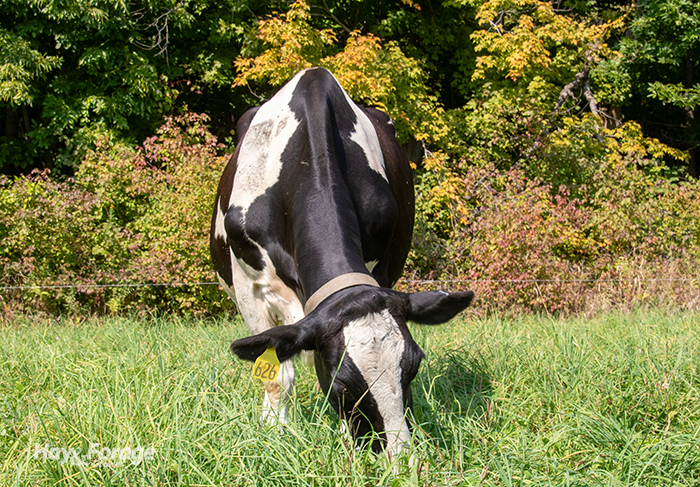
One of the favorite parts of my job is getting to visit farms all over the country. Having boots-on-the-ground experience in hay and pasture systems across the U.S. is the best way to acquire unique perspectives and interesting stories for our readers. On a more selfish note, it also gives me the chance to step outside my comfort zone and broaden my personal understanding of various pockets of the forage industry.
So far this season, I’ve made stops in Louisiana, Mississippi, Minnesota, Utah, and Kansas, and I rounded out my summer travel with a trip to New England. It’s a region of the country I’ve never ventured to before, and the only piece of advice I received on my way out the door was to avoid eating lobster during months that are spelled without the letter “R.” Needless to say, I had little idea of Northeastern agriculture.
While there, I visited a grazing beef farm in Maine that was in the midst of some pasture renovations, a New Hampshire dairy farm with an emphasis on organic milk and baleage production, and a grazing dairy in Vermont that uses all of its milk to make a wide array of artisanal cheeses on-site.
Every operation was geared toward a different output, and their respective hay and grazing systems reflected those goals. Therefore, our discussions inevitably went in different directions regarding forage production, but there was one common theme that came up in every conversation: reed canarygrass.
Ragging on reed canarygrass
It wasn’t just the mention of reed canarygrass that caught my attention, but rather the growing level of disdain that laced every description of the cool-season perennial. At my first stop, the beef farmers in Maine simply chalked it up to a less-than-desirable species that grows in low-lying areas of their pastures.
The New Hampshire dairy farmer expressed a more amplified aversion to reed canarygrass, especially when it gets too mature. His cows graze young, short plants at the start of the season, but even then, reed canarygrass is less palatable and lower quality than the other forages in his system. Later in the rotation, the herd selectively grazes around taller stalks.
Walking toward the grazing herd at the dairy in Vermont, I inquired about the pasture base. In addition to orchardgrass, Kentucky bluegrass, and a diverse mix of clover, some fields also included plantain, vetch, and various other grasses. To passively stoke the flames of reed canarygrass slander, I asked the farmer if there were any forages that she doesn’t particularly enjoy.
“I don’t like reed canarygrass,” she said without hesitation.
Ding, ding, ding. I was three for three. Not only did this farmer denounce the unpalatability of reed canarygrass, but also the fact that it thrives in wet spots, indicating problem areas in her pasture. Upon entering a field with an abundance reed canarygrass, she not only assumes cows will struggle to meet their nutritional needs, but she also worries about the damage their hoof traffic will cause in saturated soils.
Persistence and unpalatability
Reed canarygrass is a sod-forming grass that spreads via rhizomes. It is, in fact, adapted to low-lying, wet areas, and it is the most flood-tolerant cool-season grass among the major species. Reed canarygrass also tends to have a high tolerance to drought and heat, which lends itself to good regrowth, to many farmers’ dismay.
According to research from the Northeast, reed canarygrass regrowth yield represents a higher percentage of total season yield than other forages like timothy and smooth bromegrass. With that said, reed canarygrass falls behind orchardgrass, timothy, smooth bromegrass, Kentucky bluegrass, and ryegrass in terms of forage quality and palatability.
Indole alkaloids can explain the unpalatability of reed canarygrass, and concentrations of these alkaloids are negatively correlated with animal health and weight gain. The compounds accumulate in leaf blades more so than leaf sheaths and stems, and warmer temperatures expedite alkaloid production, whereas younger spring growth may be less toxic.
Although there are improved cultivars of reed canarygrass that contain lower alkaloid concentrations, it’s not a species that is readily reseeded in perennial pastures — at least not on the farms I visited in New England. These farmers essentially relied on the grass stands to sustain themselves, and for the most part, strategic grazing sufficed as the primary tool for forage management in the decades-old fields I found myself standing in.
Despite being a thorn in the side of each system, reed canarygrass seemed to be a relatively bearable species. Understanding its plant properties and growth characteristics allowed the farmers to tailor their grazing plans around the unwanted forage and ensure their cattle would perform well regardless of an undesirable item on the menu. Other practices — like frost seeding red clover — were also being implemented across the board to add and/or maintain forage quality throughout the growing season for grazing livestock and hay production.
One final note about reed canarygrass is that even though it is very winterhardy, its leaves are extremely susceptible to frost damage. Therefore, reed canarygrass quality can take a significant hit when Northeastern pastures experience freezing temperatures, which is already starting to occur overnight. If there is only one connection between reed canarygrass and New England lobster, perhaps it is to avoid both during months that are spelled without the letter “R.”

